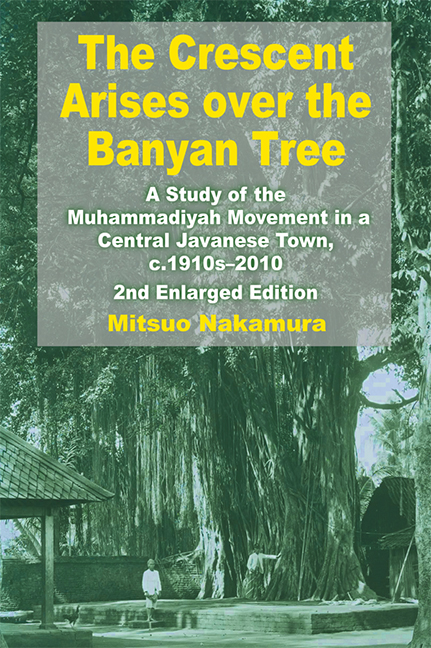 The Crescent Arises over the Banyan Tree
The Crescent Arises over the Banyan Tree Book contents
- Frontmatter
- Dedication
- Epigraph
- Contents
- List of Figures and Maps
- List of Tables
- List of Boxes
- Foreword to the Second Edition
- Preface to the Second Edition
- Foreword to the First Edition
- Preface to the First Edition
- Notes
- Map
- PART I DEVELOPMENT OF THE MUHAMMADIYAH IN KOTAGEDE, c.1910s–1972
- 1 Introduction: The Islamization of Java
- 2 Kotagede under the Banyan Tree: Traditional Society and Religion
- 3 The Beginning of the Muhammadiyah: Court Religious Officials and the Urban Middle Class
- 4 The Development of the Muhammadiyah: Religion and Social Action
- 5 The Sociology of Ummat Islam: Structure and Anti-Structure
- 6 The Ideology of the Muhammadiyah: Tradition and Transformation
- 7 Conclusion: Re-Islamization of Java
- Postscript to Part I
- PART II KOTAGEDE REVISITED, 1972–2010
- Bibliography
- Glossary
- Appendices
- Index
- About the Author
2 - Kotagede under the Banyan Tree: Traditional Society and Religion
from PART I - DEVELOPMENT OF THE MUHAMMADIYAH IN KOTAGEDE, c.1910s–1972
Published online by Cambridge University Press: 21 October 2015
- Frontmatter
- Dedication
- Epigraph
- Contents
- List of Figures and Maps
- List of Tables
- List of Boxes
- Foreword to the Second Edition
- Preface to the Second Edition
- Foreword to the First Edition
- Preface to the First Edition
- Notes
- Map
- PART I DEVELOPMENT OF THE MUHAMMADIYAH IN KOTAGEDE, c.1910s–1972
- 1 Introduction: The Islamization of Java
- 2 Kotagede under the Banyan Tree: Traditional Society and Religion
- 3 The Beginning of the Muhammadiyah: Court Religious Officials and the Urban Middle Class
- 4 The Development of the Muhammadiyah: Religion and Social Action
- 5 The Sociology of Ummat Islam: Structure and Anti-Structure
- 6 The Ideology of the Muhammadiyah: Tradition and Transformation
- 7 Conclusion: Re-Islamization of Java
- Postscript to Part I
- PART II KOTAGEDE REVISITED, 1972–2010
- Bibliography
- Glossary
- Appendices
- Index
- About the Author
Summary
‘YELLOW, THREE LEGGED TURTLE TO KOTAGEDE.’ A yellow turtle having only three legs, found recently on the Samas seashore (22 km south of Yogya city) by a boatman, has been handed over by the Bantul Regional Chief to the guard of the Siliran bathing complex near the Kotagede royal cemetery to be further kept there as an extraordinary pet turtle by order of the Yogyakarta kraton [court]. A yellow or white turtle is rare and considered as a sacred beast by some people here. Kedaulatan Rakyat, 11 December 1973, “Latest News in Brief ” (English original).
ROYAL CEMETERY AND MARKET
The town of Kotagede was founded in the middle of the sixteenth century by Pamanahan Ki Gede Mataram, a captain of the king of Pajang, the first Islamized kingdom in south Central Java. Raffles narrates the beginning of the town, on the basis of indigenous chronicles available to him in the early nineteenth century, as follows:
to Panambahan [Ki Gede Mataram] was assigned a population of eighteen hundred working men in the district of Mentauk, afterwards called Matarem … The province of Mentauk or Matarem at that period did not contain more than three hundred villages, scattered in different parts of the country. On the arrival of Panambahan near Brambanan [Prambanan], he was received by the Sunan Adi Jaga [Sunan Kalijaga], who would not allow him to perform the usual ceremony of kissing his feet, thus by implication predicting the future greatness of his descendants. At Pasar Gede [Kotagede], then a wilderness, Panambahan was duly installed, under the title of Kiai Gede Matarem. (Raffles 1817 [1965] vol. II, p. 142)
Ki Gede Mataram died in 1584 and was buried in the courtyard of the mosque of the town. His son, who later became known by the title Panembahan Senapati Ingalaga, succeeded him. Senapati was called “Prince to the north of the market” (Ngabehi-lor-ing-pasar) while he was still young residing in the capital of Pajang. Senapati destroyed the kingdom of Pajang, established his own kingdom, Mataram, and made Kotagede the seat of his court (kraton) in 1587.
- Type
- Chapter
- Information
- The Crescent Arises over the Banyan TreeA Study of the Muhammadiyah Movement in a Central Javanese Town, c.1910s-2010 (Second Enlarged Edition), pp. 18 - 50Publisher: ISEAS–Yusof Ishak InstitutePrint publication year: 2012


